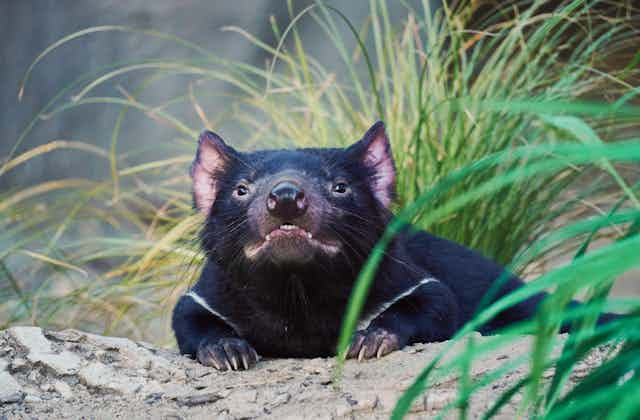Tasmanian devils are tough little creatures with a ferocious reputation. Tragically, each year thousands of Tasmanian devils suffer and die from contagious cancers – devil facial tumours.
We have discovered that a modified virus, like the attenuated adenovirus used in the AstraZeneca COVID-19 vaccine, can make devil facial tumour cells more visible to the devil immune system.
We have also found key immune targets on devil facial tumour cells. These combined advances allow us to move forward with a vaccine that helps the devil immune system find and fight the cancer.
And we have a clever way to deliver this vaccine, too – with edible baits.
A puzzling cancer
Tasmanian devils mainly suffer from the original devil facial tumour, or DFT1. A second type of devil facial tumour (DFT2) has begun emerging in southern Tasmania that further threatens the already endangered devil population.
DFT1 and DFT2 are transmissible cancers – they spread living cancer cells when the devils bite each other.
Read more: Deadly disease can 'hide' from a Tasmanian devil's immune system
This has presented a puzzle: a cancer cell that comes from another animal should be detected by the immune system as an invader, because it is “genetically mismatched”. For example, in human medicine, tissue transplants need to be genetically matched between the donor and recipient to avoid the immune system rejecting the transplant.
Somehow, DFT1 and DFT2 seem to evade the immune system, and devils die from tumours spreading throughout their body or from malnutrition due to the facial tumours disrupting their ability to eat.

On the bright side, the immune systems of a few wild devils have been able to overcome DFT1. Furthermore, previous vaccine and immunotherapy trials showed the devil immune system can be activated to kill DFT1 cells and clear away sizeable tumours.
Read more: Genome map project uncovers first Tasmanian devil to fight off face tumour
This good news from both the field and the laboratory has allowed our team to zoom in on key DFT protein targets that the devil immune system can attack. This helps us in our quest to develop a more effective and scalable vaccine.
How can we vaccinate wild animals?
Even if we succeed in producing a protective DFT vaccine, we can’t trap and inject every devil.
Luckily, clever researchers in Europe in the 1970s figured out that vaccines can be incorporated into edible food baits to vaccinate wildlife across diverse landscapes and ecosystems.
In 2019, we hypothesised an oral bait vaccine could be made to protect devils from DFT1 and DFT2. Fast forward to November 2022 and the pieces of this ambitious project are falling into place.
First, using samples from devils with strong anti-tumour responses, we have found that the main immune targets are major histocompatibility proteins. These are usually the main targets in transplant rejection. This tells us what to put into the vaccine.
Second, we tested a virus-based delivery system for the vaccine. We used a weakened adenovirus most of the human population has already been exposed to, and found that in the lab this virus can enter devil facial tumour cells.
Importantly, the weakened adenovirus can be modified to produce proteins that can stimulate the devil immune system. This means it forces the devil facial tumour cells to show the major histocompatibility proteins they normally hide, making the cells “visible” to cancer-killing immune cells.
This vaccine approach is much like the AstraZeneca COVID-19 vaccine that uses a weakened chimpanzee adenovirus to deliver cargo to our immune system, getting it to recognise SARS-CoV-2. Adenoviral vaccines have also been widely used in oral bait vaccines to protect raccoons from the rabies virus.
Edible protection
But there were additional challenges to overcome. Our collaborators in the USA who research and develop other wildlife vaccines suggested that developing an effective bait for devils might be as challenging as making the vaccine itself.
Our first studies of placebo baits in the wild confirmed this. Contrary to previous studies which showed devils eating most of the baits, we found the baits were also readily consumed by other species, including eastern quolls, brushtail possums, and Tasmanian pademelons.
This led us to test an automatic bait dispenser supplied by our collaborators at the US Department of Agriculture National Wildlife Research Center. The dispensers proved quite effective at reducing the amount of “off target” bait consumption and showed devils could successfully retrieve the baits with their dexterous paws.
Encouragingly, a recent mathematical modelling study suggests an oral bait vaccine could eliminate DFT1 from Tasmania.
Successful delivery of the vaccine would be a demanding and long-term commitment. But with it, we could prevent the suffering and deaths of thousands of individual devils, along with helping to reestablish a healthy wild devil population.
Can’t stop now
A bit of additional good news fell into place in late 2022 with the announcement that our international team was awarded an Australian Research Council Linkage Project grant to develop better baits and ways to monitor wildlife health in the field.
These oral bait vaccine techniques that eliminate the need to catch and jab animals could be applied to future wildlife and livestock diseases, not just Tassie devils.
Building on this momentum, we are planning to start new vaccine trials in 2023. We don’t know yet if this new experimental vaccine can prevent devils from getting devil facial tumours.
However, the leap we have made in the past three years and new technology gives us momentum and hope that we might be able to stop DFT2 before it spreads across the state. Perhaps, we can even eliminate DFT1.
Read more: Tasmanian devils look set to conquer their own pandemic

